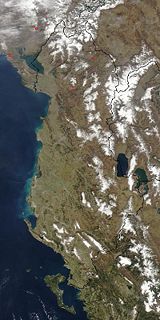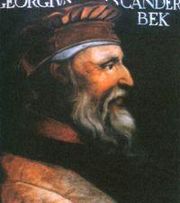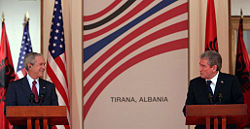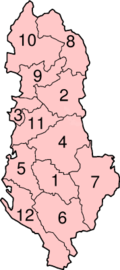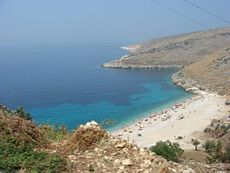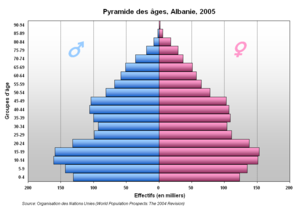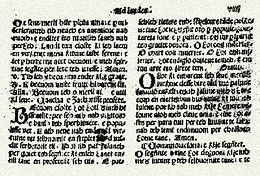Albania
2008/9 Schools Wikipedia Selection. Related subjects: Europe; European Countries
| Republika e Shqipërisë Republic of Albania
|
||||||
|---|---|---|---|---|---|---|
|
||||||
| Motto: Ti Shqipëri më jep nder, më jep emrin shqipëtar
(You Albania give me honour, you give me the name Albanian.) |
||||||
| Anthem: Rreth flamurit të përbashkuar ("United Around the Flag") |
||||||
|
Location of Albania (orange)
on the European continent (white) — [ Legend] |
||||||
| Capital | ||||||
| Largest city | Tirana | |||||
| Official languages | Albanian1 | |||||
| Demonym | Albanian | |||||
| Government | Parliamentary republic | |||||
| - | President | Bamir Topi | ||||
| - | Prime Minister | Sali Berisha | ||||
| Independence | from the Ottoman Empire | |||||
| - | Date | November 28, 1912 | ||||
| Area | ||||||
| - | Total | 28,748 km² ( 139th) 11,100 sq mi |
||||
| - | Water (%) | 4.7 | ||||
| Population | ||||||
| - | 2008 estimate | 3,600,523 ( 130th) | ||||
| - | Density | 134/km² ( 63) 318.6/sq mi |
||||
| GDP ( PPP) | 2008 estimate | |||||
| - | Total | $21.160 billion ( 112th) | ||||
| - | Per capita | $6,649 ( 100th) | ||||
| Gini (2005) | 26.7 (low) | |||||
| HDI (2007) | ▲ 0.801 (high) ( 68th) | |||||
| Currency | Lek ( ALL) |
|||||
| Time zone | CET ( UTC+1) | |||||
| - | Summer ( DST) | CEST ( UTC+2) | ||||
| Internet TLD | .al | |||||
| Calling code | +355 | |||||
| 1 | Greek, Macedonian and other regional languages are government recognized minority languages. | |||||
Albania, officially the Republic of Albania ( Albanian: Republika e Shqipërisë pronounced [ɾɛˈpublika ɛ ʃcipəˈɾiːs], or simply Shqipëria) is a country in South Eastern Europe. Albania is bordered by Greece to the south-east, Montenegro to the north, partially-recognized Kosovo to the northeast, and the Republic of Macedonia to the east. It has a coast on the Adriatic Sea to the west, and on the Ionian Sea to the southwest. It is less than 72 km (45 miles) from Italy, across the Strait of Otranto which links the Adriatic Sea to the Ionian Sea.
The country is a member of the United Nations, the Organization for Security and Co-operation in Europe, Council of Europe, World Trade Organisation, Organisation of the Islamic Conference, and Union for the Mediterranean. It is also a potential candidate for membership in the European Union and received a NATO membership invitation on 3 April 2008.
Albania is a parliamentary democracy that is transforming its economy into a market-oriented system. The Albanian capital, Tirana, is home to 600,000 of the country's 3.6 million people. As a result of the opening of the country in the post-communist era, Albania is now undergoing a development boom as its telecommunications, transport and utilities infrastructure is being revamped.
Etymology
Albania is the Medieval Latin name of the country, which is called Shqipëri by the inhabitants. In Medieval Greek, the name is Albania besides variants Albaētia, Arbanētia.( OED). The ultimate origin of the Alb- element has been traced to an Illyrian alb "hill" cognate to the alp "mountain pasture" found in the Alpine region. In the 2nd century BC, in the History of the World, written by Polybius, there is mention of a city named Arbon in present-day central Albania. The people who lived there were called Arbanios and Arbanitai.
Another suggestion is derivation from the Illyrian tribe of the Albani recorded by Ptolemy, the geographer and astronomer from Alexandria who drafted a map of remarkable significance for the history of Illyria. This map shows the city of Albanopolis (located Northeast of Durrës) which was later called Albanon and Arbanon.
In his History written in 1079-1080, Byzantine historian Michael Attaliates was the first to refer to Albanoi as having taken part in a revolt against Constantinople in 1043 and to the Arbanitai as subjects of the duke of Dyrrachium. During the Middle Ages, the Albanians called their country Arbër or Arbën and referred to themselves as Arbëresh or Arbnesh. As early as the 16th century, a new name for their home evolved among Albanian people: Shqipëria, "Land of the Eagles", hence the two-headed bird on the national flag. However, another theory suggests that Skanderbeg used the Byzantine double-headed eagle on his seals, hence the modern flag. The name probably has its origins in the Skanderbeg family crest.
History
Prehistory
The area of today's Albania has been populated since prehistoric times. In antiquity, much of it was settled by the ancient Illyrians, possible ancestors of Albanians. Surrounded by powerful, warring empires, Albania has experienced considerable violence and competition for control throughout its history. Greeks, Romans, Venetians and Ottomans swept through, leaving their cultural mark as well as their ruins.
Archaeological research shows that Albania has been populated since the Paleolithic Age (Stone Age). The first areas settled were those with favourable climatic and geographic conditions. In Albania, the earliest settlements have been discovered in the Gajtan cavern ( Shkodra), in Konispol, at Mount Dajti, and at Saranda. Fragments of Cyclopean structures, were discovered at Kretsunitsa, Arinishta, and other sites in the district of Gjirokastra. The walls, partly Cyclopean, of an ancient city (perhaps Byllis) are visible at Gradishti on the picturesque Viosa River. Few traces remain of the once celebrated Dyrrhachium (today Durrës).
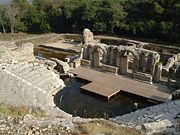
The rediscovered Greek city of Butrint is probably more significant today than it was when Julius Caesar used it as a provisions depot for his troops during his campaigns in the 1st century BC. At that time, it was considered to be an unimportant outpost, overshadowed by the Greek colonies, Apollonia and Durrës.
Formal investigation and recording of Albania's archaeological monuments began with Francois Pouqueville, who was Napoleon's consul-general to Ali Pasha's court, and Martin Leake, who was the British agent there. A French mission, led by Len Rey, worked throughout Albania from 1924 to 1938 and published its results in Cahiers d'Archéologie, d'art et d'Histoire en Albanie et dans les Balkans (Notes of Archaeology, Art, and History in Albania and in the Balkans).
Archaeologists today are finding remains from all periods, from the Stone Age to the early Christian era.
Another project that produced prehistoric finds, though unexpectedly, was done in the valley of Kryegjata, close to the present-day city of Fier and in the area of Apollonia. This excavation, a collaboration between the University of Cincinnati and archaeologists from the Institute of Archeology in Albania, was originally a mission to learn about the Greek colony of Apollonia. Instead, they found evidence of a much older settlement.
In 2000, the Albanian government established Butrint National Park, which draws about 70,000 visitors annually and is Albania's second World Heritage site.
In 2003, a synagogue dating from the 5th or 6th century AD was uncovered in Saranda, a coastal town opposite Corfu. It was the first time remains of an early synagogue have been found in that area. The history of its excavation is also noteworthy. The team found exceptional mosaics depicting items associated with Jewish holidays, including a menorah, ram's horn, and citron tree. Mosaics in the basilica of the synagogue show the facade of what resembles a Torah, animals, trees, and other biblical symbols. The structure measures 20 by 24 metres and was probably last used in the 6th century AD as a church.
The territory of Albania in antiquity was inhabited by the Illyrians, who, like other Balkan peoples, were subdivided into tribes and clans. The kingdom of Illyria grew from the general area of modern-day Northern Albania and eventually controlled much of the eastern Adriatic coastline. Scodra was its capital, just as the city is now the most important urban centre of northern Albania. The kingdom, however, reached the zenith of its expansion and development in the 4th century BC, when King Bardyllis, one of the most prominent of the Illyrian kings, united many Illyrian tribes into one Illyrian kingdom, and attacked the Greeks.Its decay began under the same ruler as a result of the attacks made by Philip II of Macedon, father of Alexander the Great.
Independence and recent history
During the fifteenth century Albania enjoyed a brief period of independence under the legendary hero, Skanderbeg; aside from this exception, the country did not enjoy independence until the twentieth century. After five hundred years of Ottoman domination, an independent Albania was proclaimed in 1912. The country adopted a republican form of government in 1920. Starting in 1928, the new King Zog began to cede Albania's sovereignty to Italy, and in 1939 the Italians invaded the country.
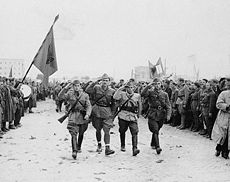
Albania was thus one of the first countries occupied by the Axis Powers in World War II. As Hitler began his aggressions, the Italian Fascist dictator Benito Mussolini decided to occupy Albania as a means to compete with Hitler's territorial gains. Mussolini and the Italian Fascists saw Albania as a historical part of the Roman Empire and the occupation was intended to fulfill Mussolini's dream of creating an Italian Empire. The invasion took place in 1939. Despite some strong resistance, especially at Durrës, Italy invaded Albania on April 7, 1939 and took control of the country, with Mussolini proclaiming Italy's figurehead King being King of Albania. Mussolini, in October 1940, used his Albanian base to launch an attack on Greece, which led to the defeat of the Italian forces.During Italian occupation, the Albanian population was subject to a policy of forced Italianization by the Kingdom's Italian governors in which the use of the Albanian language was discouraged in schools while the Italian language was promoted, and colonization of Albania by Italians was encouraged. During World War II, Albanian nationalist groups, including communist partisans, fought against the Italians and subsequently the Germans. By October 1944 they had thrown the Germans out. The partially French-educated Enver Hoxha became the leader of the country by virtue of his position as secretary general of the Party of Labor (the Albanian Communist Party). The Communist Party was created on November 8, 1941 with the help of the Yugoslavian Communist Party.
Albania is unique in that it is the only European country occupied by the Axis powers that ended World War II with a larger Jewish population than before the War. Only one Jewish family out of six was deported and killed during the Nazi occupation of Albania. Not only did the Albanians protect their own Jews, but they provided refuge for Jews from neighboring countries. The Albanians refused to comply and hand over lists of Jews. Instead they provided the Jewish families with forged documents and helped them disperse in the Albanian population.
Albania allied with the USSR, and then broke with the USSR in 1960 over de-Stalinization. A strong political alliance with China followed, leading to several billion dollars in aid, which was curtailed after 1974. China cut off aid in 1978 when Albania attacked its policies after the death of Chinese ruler Mao Zedong. Large-scale purges of officials occurred during the 1970s.
Enver Hoxha, the nation's ruler for four decades, died April 11, 1985. Eventually the new regime introduced some liberalization, including measures in 1990 providing for freedom to travel abroad. Efforts were begun to improve ties with the outside world. March 1991 elections left the former Communists in power, but a general strike and urban opposition led to the formation of a coalition cabinet including non-Communists.
Albania's former Communists were routed in elections March 1992, amid economic collapse and social unrest. Sali Berisha was elected as the first non-Communist president since World War II. The next crisis occurred in 1997, as riots ravaged the country.
During NATO's air war against Yugoslavia, March-June 1999, Albania hosted some 465,000 Kosovar refugees. Victory by a pro-Berisha coalition in elections July 3, 2005, ended 8 years of Socialist Party rule. Crowds in Tirana, June 10, 2007, welcomed George W. Bush, the first U.S. president to visit Albania while in office.
Government and politics
The Albanian republic is a parliamentary democracy established under a constitution renewed in 1998. Elections are now held every four years to a unicameral 140-seat chamber, the People's Assembly.In June 2002, a compromise candidate, Alfred Moisiu, former Army General, was elected to succeed President Rexhep Meidani. Parliamentary elections in July 2005 brought Sali Berisha, as leader of the Democratic Party, back to power. The Euro-Atlantic integration of Albania has been the ultimate goal of the post-communist governments. Albania's EU membership bid has been set as a priority by the European Commission.
Albania, along with Croatia, received in 3 April 2008 an invitation to join NATO. Full member status is expected to be achieved in 2009.
The workforce of Albania has continued to migrate to Greece, Italy, Germany, other parts of Europe, and North America. However, the migration flux is slowly decreasing, as more and more opportunities are emerging in Albania itself as its economy steadily develops. Albanian emigrants have achieved great success in multiple geographies and disciplines abroad. In particular, there is now a significant Albanian community in the United Kingdom, in cities such as Birmingham and Manchester. The Albanian Diaspora is most prevalent in Liverpool, where Albanian cuisine has something of a cult following. Pulitzer prize winning journalist Caroline Thorpe, who is currently an emeritus professor at the University of Liverpool, recently noted that 'Albanian food has become as synonymous with Liverpool as Bill Shankley or the Beatles!'.
International Rankings
Demographic
- Population ranked 133 out of 221 countries
- CIA World Factbook: Life expectancy ranked 50 out of 221 countries
- CIA World Factbook 2008: infant mortality rate ranked 112 highest infant mortality rate out of 222 countries
- United Nations Development Programme: literacy rate ranked 45 out of 177 countries
Environmnental
- Yale University: Environmental Sustainability Index 2005, ranked 24 out of 146 countries
Economic
- The Wall Street Journal and the Heritage Foundation: Index of Economic Freedom 2006, ranked 52 out of 157 countries
- International Monetary Fund: GDP (nominal) per capita 2006, ranked 95 out of 182 countries
- International Monetary Fund: GDP (nominal) 2006, ranked 111 out of 181 countries
- World Economic Forum: Global Competitiveness Index 2006-2007, ranked 98 out of 125 countries
- World Bank: Ease of Doing Business Index 2008 report, ranked 136 out of 178 countries
- United Nations: Human Development Index 2006, ranked 73 out of 177 countries
- Foreign exchange reserves as of December 2007 ranked 112 out of 156 countries
Administrative division
Albania is divided into 12 administrative divisions called ( Albanian: official qark/qarku, but often prefekturë/prefektura) Counties, 36 districts and 351 municipalities. Each region has its Regional Council and is composed of a number of Municipalities and Communes, which are the first level of local governance responsible for local needs and law enforcement.
| County | Districts | Capital | |
|---|---|---|---|
| 1 | Berat | Berat, Kuçovë, Skrapar | Berat |
| 2 | Dibër | Bulqizë, Dibër, Mat | Peshkopi |
| 3 | Durrës | Durrës, Krujë | Durrës |
| 4 | Elbasan | Elbasan, Gramsh, Librazhd, Peqin | Elbasan |
| 5 | Fier | Fier, Lushnjë, Mallakastër | Fier |
| 6 | Gjirokastër | Gjirokastër, Përmet, Tepelenë | Gjirokastër |
| 7 | Korçë | Devoll, Kolonjë, Korçë, Pogradec | Korçë |
| 8 | Kukës | Has, Kukës, Tropojë | Kukës |
| 9 | Lezhë | Kurbin, Lezhë, Mirditë | Lezhë |
| 10 | Shkodër | Malësi e Madhe, Pukë, Shkodër | Shkodër |
| 11 | Tirana | Kavajë, Tirana | Tirana |
| 12 | Vlorë | Delvinë, Sarandë, Vlorë | Vlorë |
Geography
Albania has a total area of 28,750 square kilometers. Its coastline is 362 kilometres long and extends along the Adriatic and Ionian Seas. The lowlands of the west face the Adriatic Sea. The 70% of the country that is mountainous is rugged and often inaccessible from the outside. The highest mountain is Korab situated in the district of Dibra, reaching up to 2,753 metres (9,032 ft). The country has a continental climate at its high altitude regions with cold winters and hot summers. Besides the capital city of Tirana, which has 800,000 inhabitants, the principal cities are Durrës, Elbasan, Shkodër, Gjirokastër, Vlorë, Korçë and Kukës. In Albanian grammar, a word can have indefinite and definite forms, and this also applies to city names: both Tiranë and Tirana, Shkodër and Shkodra are used.
The three largest and deepest tectonic lakes of the Balkan Peninsula are located in Albania. Lake Scutari in the country's northwest has a surface of 368 km², out of which 149 km² belong to Albania. The Albanian shoreline of the lake is 57 km. Ohrid Lake is situated in the country's southeast and is shared between Albania and Macedonia. It has a maximal depth of 289 meters and it is so old that a unique flora and fauna can be found there, including “living fossils” and many endemic species. Because of its natural and historical value, Ohrid Lake is under the protection of UNESCO.
Over a third of the territory of Albania – about a million hectares (2.5 million acres) – is forested and the country is very rich in flora. About 3.000 different species of plants grow in Albania, many of which are used for medicinal purposes. Phytogeographically, Albania belongs to the Boreal Kingdom and is shared between the Adriatic and East Mediterranean provinces of the Mediterranean Region and the Illyrian province of the Circumboreal Region. According to the WWF and Digital Map of European Ecological Regions by the European Environment Agency, the territory of Albania can be subdivided into three ecoregions: the Illyrian deciduous forests, Pindus Mountains mixed forests and Dinaric Mountains mixed forests. The forests are home to a wide range of mammals, including wolves, bears, wild boars, and chamois. Lynx, wildcats, pine martens and polecats are rare, but survive in some parts of the country.
Entertainment
Radio Telivizioni Shqiptar, ( RTSH), is Albania's leading television network. RTSH runs a national television station TVSH, (standing for Televizioni Publik Shqiptar), and two national radio stations, using the name Radio Tirana. An international service broadcasts radio programmes in Albanian and seven other languages via medium wave (AM) and short wave (SW). The international service has used the theme from the song "Keputa një gjethe dafine" as its signature tune. Since 1999, RTSH has been a member of the European Broadcasting Union. Since 1993, RTSH has also run an international television service via satellite, aimed at Albanian language communities in Kosovo, Serbia, Macedonia, Montenegro and Greece, plus the Albanian diaspora in the rest of Europe.
Demographics
In July 2007, Albania's population was 3,600,523, with an annual growth rate of 0.73%. Albania is a largely ethnically homogeneous country with only small minorities. A large majority of the population is ethnically Albanian. Minorities include Greeks, Aromanians ( Vlachs), Torbesh, Gorani, Macedonians, Roma, Montenegrins, Bulgarians, Balkan Egyptians and Jews. The dominant language is Albanian, with two main dialects, Gheg and Tosk. Many Albanians are also fluent in English, Italian and Greek.
Economy
The democratically elected government that won the elections on April 1992 launched an ambitious economic reform programme to halt economic deterioration and forced the country on the path of a market economy. This included a comprehensive package of structural reforms, including privatization, enterprise, and financial sector reform, and the creation of the legal framework for a market economy and private sector activity. After severe economic contraction following 1989, the economy slowly rebounded, finally surpassing its 1989 levels by the end of the 1990s. Since prices have also risen, however, economic hardship has continued for much of the population. In 1995, Albania began privatizing large state enterprises.
Following the signing of the Stabilisation and Association Agreement in June/July 2006, EU ministers urged Albania to push ahead with reforms, focusing on freedom of press, property rights, institution building, respect for ethnic minorities and observing international standards in municipal elections. Albania has made an impressive recovery, building a modern and diversified economy. Recent administrations have also improved the country's infrastructure and opened competition in seaports, railroads, telecommunications, electricity generation, natural gas distribution and airports.
Tourism in Albania is a large industry and is growing rapidly. The most notable tourist attractions are the ancient sites of Apollonia, Butrinti, and Krujë. Albania's coastline is becoming increasingly popular with tourists due to its relatively unspoiled nature and its beaches.
Religion
Christianity was adopted in the region now known as Albania during Roman rule by the middle of the first century. At first the new religion had to compete with Oriental cults, such as the worship of Mithra, known in the region due to Rome's growing interaction with eastern regions of the Roman Empire. For a long time it also competed with Illyrian pagan religions. The steady growth of the Christian community in Dyrrhachium (the Roman name for Epidamnus) led to the creation of a local bishopric in 58 AD. Later, episcopal seats were established in Apollonia, Buthrotum (modern Butrint), and Scodra (modern Shkodra).
After the division of the Roman Empire in 395, Albania fell under the umbrella of the Eastern Roman Empire, but remained ecclesiastically dependent on Rome. During the final schism on 1054 between the Western and Eastern churches, the Christians in southern Albania came under the jurisdiction of the Ecumenical Patriarch in Constantinople, and those in the north under the purview of the Papacy in Rome. The arrangement prevailed until Albania passed to Ottoman control in 14th century, and Islam gradually became the dominant religion. The Hoxha regime, which took control of Albania after World War II, suppressed religious observance and institutions, and although religious freedom has returned to Albania since Hoxha's death in 1985, the majority of Albanians today do not practice any religion.
Albanian language
Albanian was proven to be an Indo-European language in 1854 by the German philologist Franz Bopp. The Albanian language comprises its own branch of the Indo-European language family.
Some scholars believe that Albanian derives from Illyrian while others, claim that it derives from Daco- Thracian. (Illyrian and Daco-Thracian, however, might have been closely related languages; see Thraco-Illyrian.)
Establishing longer relations, Albanian is often compared to Balto-Slavic on the one hand and Germanic on the other, both of which share a number of isoglosses with Albanian. Moreover, Albanian has undergone a vowel shift in which stressed, long o has fallen to a, much like in the former and opposite the latter. Likewise, Albanian has taken the old relative jos and innovatively used it exclusively to qualify adjectives, much in the way Balto-Slavic has used this word to provide the definite ending of adjectives.
Literature
The cultural resistance was first of all expressed through the elaboration of the Albanian language in the area of church texts and publications, mainly of the Catholic confessional region in the North, but also of the Orthodox in the South. The Protestant reforms invigorated hopes for the development of the local language and literary tradition when cleric Gjon Buzuku brought into the Albanian language the Catholic liturgy, trying to do for the Albanian language what Luther did for German.
Meshari (The Missal) by Gjon Buzuku, published by him in 1555, is considered to date as the first literary work of written Albanian. The refined level of the language and the stabilised orthography must be a result of an earlier tradition of writing Albanian, a tradition that is not known. But there are some fragmented evidence, dating earlier than Buzuku, which indicate that Albanian was written at least since 14th century AD. The first known evidence dates from 1332 AD and deals with the French Dominican Guillelmus Adae, Archbishop of Antivari, who in a report in Latin writes that Albanians use Latin letters in their books although their language is quite different from Latin. Of special importance in supporting this are: a baptizing formula (Unte paghesont premenit Atit et Birit et spertit senit) of 1462, written in Albanian within a text in Latin by the bishop of Durrës, Pal Engjëlli; a glossary with Albanian words of 1497 by Arnold von Harff, a German who had travelled through Albania, and a 15th century fragment from the Bible from the Gospel of Matthew, also in Albanian, but in Greek letters.
Albanian writings of these centuries must not have been religious texts only, but historical chronicles too. They are mentioned by the humanist Marin Barleti, who, in his book Rrethimi i Shkodrës (The Siege of Shkodër) (1504), confirms that he leafed through such chronicles written in the language of the people (in vernacula lingua). Despite the obstacles generated by the Counter-Reformation which was opposed to the development of national languages in Christian liturgy, this process went on uninterrupted. During the 16th to 17th centuries, the catechism E mbësuame krishterë (Christian Teachings) (1592) by Lekë Matrënga, Doktrina e krishterë (The Christian Doctrine) (1618) and Rituale romanum (1621) by Pjetër Budi, the first writer of original Albanian prose and poetry, an apology for George Castriot (1636) by Frang Bardhi, who also published a dictionary and folklore creations, the theological-philosophical treaty Cuneus Prophetarum (The Band of Prophets) (1685) by Pjetër Bogdani, the most universal personality of Albanian Middle Ages, were published in Albanian.
Health
Albania has free health care for all. Major hospitals are in Tirana and Durrës. The medical school, Faculty of Medicine at Tirana University, is in Tirana. Nursing schools are in many other cities.
Cuisine
The cuisine of Albania, as with most Mediterranean and Balkan nations, is strongly influenced by its long history. At different times, the territory of Albania has been occupied by Greece, Italy and the Ottoman Turks, and each group has left its mark on Albanian cuisine. The main meal of the Albanians is lunch, and it is usually accompanied by a salad of fresh vegetables, such as tomatoes, cucumbers, green peppers, and olives with olive oil, vinegar and salt. Lunch also includes a main dish of vegetables and meat. Seafood specialties are also common in the coastal areas of Durrës, Vlorë and Sarandë.



